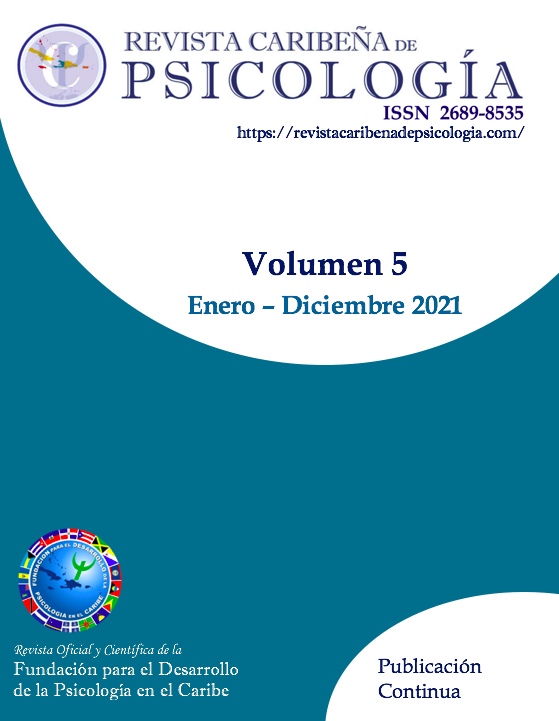Descriptive Paraphilic Behaviors in the General Non-Clinical Population in Puerto Rico
DOI:
https://doi.org/10.37226/rcp.v5i1.5543Palabras clave:
parafilias, fantasias sexuales, deseos sexuales, conducta sexual, conductas sexuales atípicasResumen
The objectives of this study were: 1) describe paraphilic sexual activities in Puerto Rico, identifying differences between fantasies, urges, or behaviors of specific paraphilias, 2) explore if there are relations between sexual fantasies and acting out (behavior) those fantasies, 3) explore the satisfaction with their lives, mental health and worries about the sexual behavior of those who report paraphilic behaviors, and 4) describe the feelings during and after having atypical fantasies, desired and/or behavior. A total of 1,255 participants completed an online survey, including socio-demographics, specific sexual fantasies, urges and behaviors, and psychological variables. Participants were able to express interests between fantasies, urges, and behaviors in each paraphilic activity. Most participants had at least a college degree (78.2%), were Catholic (65%), and identify as Hispanic (86.3%). Results showed that most participants reported no sexual paraphilic activities. The most-reported activity was watching pornography, followed by partialism and voyeurism. Correlations analysis between sexual fantasies and behaviors showed a significant correlation between voyeurism with exhibitionism, frotteurism, watching your partner have sex with others, and watching pornography. These results provide new insight into the current paraphilic interests in the non-clinical population and should elicit interest in further studies.
Citas
Abdullahi, H., Jafojo, R. O., & Udofia, O. (2015). Paraphilia among undergraduates in a Nigerian University. Sexual Addiction & Compulsivity, 22(3), 249-257.
Aggrawal, A. (2009). Forensic and medico-legal aspects of sexual crimes and unusual sexual practices. CRC Press.
Ahlers, C., Schaefer,G., Mundt, I., Roll, S., Englert, H., Willich, S., & Beier, K. (2011). How unusual are the contents of paraphilias? Paraphilia-associated sexual arousal patterns in a community-based sample of men. Journal of Sexual Medicine, 8, 1362–1370.
Ahrold, T., Farmer, M., Trapnell, P., & Meston, C. (2011). The relationship among sexual attitudes, sexual fantasy, and religiosity. Archives of Sexual Behavior, 40, 619-630.
American Psychiatric Association. (2013). Diagnostic and statistical manual of the mental disorders (DSM 5). American Psychiatric Association.
American Psychological Association Dictionary of Psychology (n.d.). Pictophilia. https://dictionary.apa.org/pictophilia
Balon, R. (2013). Commentary controversies in the diagnosis and treatment of paraphilias. Journal of Sex & Marital Therapy, 39, 7–20.
Bhugra, D., Popelyuk, D., & McMullen, I. (2010). Paraphilias across cultures: Contexts and controversies. Journal of Sex Research, 47(2–3), 242–256.
Castellini, G., Rellini, A. H., Appignanesi, C., Pinucci, I., Fattorini, M., Grano, E., Fisher, A. D., Cassioli, E., Lelli, L., Maggi, M., & Ricca, V. (2018). Deviance or normalcy? The relationship among paraphilic thoughts and behaviors, hypersexuality, psychopathology in a sample of university students. The Journal of Sexual Medicine, 15(9), 1322-1335. http://doi.org/10.1016/j.jsxm.2018.07.015
Dawson, S., Bannerman, B., & Lalumiére, M. (2016). Paraphilic interests: An examination of sex differences in a non-clinical sample. Sex Abuse: A Journal of Research and Treatment, 10, 195-209.
Dombert, B., Schmidt, A. F., Banse, R., Briken, P., Hoyer, J., Neutze, J., & Osterheider, M. (2015). How common is men’s self-reported sexual interest in prepubescentchildren? Journal of Sex Research, 53(2), 214-223.
Dworkin, S., Lerum, K., & Zakaras, J. (2016). Sexuality in the global south: 50 Years of published research in the Journal of Sex Research: Inclusions, omissions, and future possibilities. Journal of Sex Research, 53(9), 1059-1064.
Fankhanel, E. H. (2010). The identity development and coming out process of gay youth in Puerto Rico. Journal of LGBT Youth, 7(3), 262-283.
Fankhanel, E., De Freitas, P., Granzig, W., & Sayers-Montalvo, S. (2011). Atypical sexual behaviors in a sample of Puerto Rican gay males. In J. Toro-Alfonso & A. Marteínez-Taboas (Eds.), Lesbianas, gays, bisexuals y Transgénero: Apuntes sobre su salud desde la psicología (pp. 141-191). Publicaciones Puertorriqueñas.
Fedoroff, J. P. (2016) Managing versus successful treating paraphilic disorders: The paradigm is changing. In S. B. Levine, C. B. Risen & S. E. Althof (Eds.), Handbook of clinical Sexuality for Mental Health Professionals (3rd ed., pp. 345- 361). Routledge.
Griffiths, D. (2012). The use of online methodologies in studying paraphilias: A review.Journal of Behavioral Addictions 1(4), 143–150.
Hopkins, T. A., Green, B. A., Carnes, P. J., & Campling, S. (2016). Varieties of intrusion: Exhibitionism and voyeurism. Sexual Addiction & Compulsivity 23(1), 4-33.
Joyal, C. & Carpentier, J. (2016). The prevalence of paraphilic interests and behaviors in the general population: A provincial survey. Journal of Sex Research, 54(2) 161-171.
Joyal, C., Cossette, A., & Lapierre, V. (2014). What exactly is an unusual sexual fantasy? The Journal of Sexual Medicine, 12(2), 328-340.
Mead, D., & Sharpe, M. (2018). Pornography and sexuality research papers at the 5th International Conference on Behavioral Addictions. Sexual Addiction & Compulsivity, 25(4), 248-268.
Money, J. (1984). Paraphilias: Phenomenology and classification. American Journal of Psychotherapy 38(2), 164-179.
Morales-Alejandro, L. I. (2018). Influencia de la religión en las prácticas sexuales de las personas adolescentes en Puerto Rico. Voces Desde El Trabajo Social, 6(1), 18-43. https://doi.org/10.31919/voces.v6i1.120
Moser, C. & Kleinplatz, P. J. (2020). Conceptualization, history, and future of the paraphilias. Annual Review of Clinical Psychology, 16, 379-399.
Olivera, W., & Adbo, C. (2010). Unconventional sexual behaviors and their associations with physical, mental and sexual health parameters: A study in 18 large Brazilian cities. Revista Brasilieira de Psiquiatría, 32, 264-274.
Ortiz, A., Soto-Salgado, M., Suárez, E., Santos-Ortiz, M., Tortolero-Luna, G., & Pérez, C. M. (2011). Sexual behaviors among adults in Puerto Rico: A population-based study. Journal of Sexual Medicine, 8(9), 2439–2449.
Phillip-Jenkins, J. (n.d.). Pornography. Britannica. https://www.britannica.com/topic/pornography
Pranzarone, G. F. (n.d.). Chronophilia. Dictionary of Sexology. https://www.researchgate.net/profile/Galdino_Pranzarone/publication/279064572_Dictionary_Of_Sexology_v10/links/558a345808ae9076016fbdf9/Dictionary-Of-Sexology-v10.pdf
Seto, M. C. (2017). The puzzle of male chronophilias. Archives of Sexual Behavior, 46, 3-22.
US Census Bureau. (2018). Quick Facts: Puerto Rico. https://www.census.gov/quickfacts/fact/table/pr#
US Census Bureau. (2019). Quick Facts, Puerto Rico. https://www.census.gov/quickfacts/PR
Wiederman, M. (1999). Volunteer bias in sexuality research using college student participants. Journal of Sex Research, 36, 59-66.
Descargas
Publicado
Cómo citar
Número
Sección
Licencia
Derechos de autor 2021 Edward Fankhanel, Caleb Esteban, Jorge Berrios, Frances Figueroa, María del C. Santos-Gómez, Eliut Rivera-Segarra

Esta obra está bajo una licencia internacional Creative Commons Atribución 4.0.







